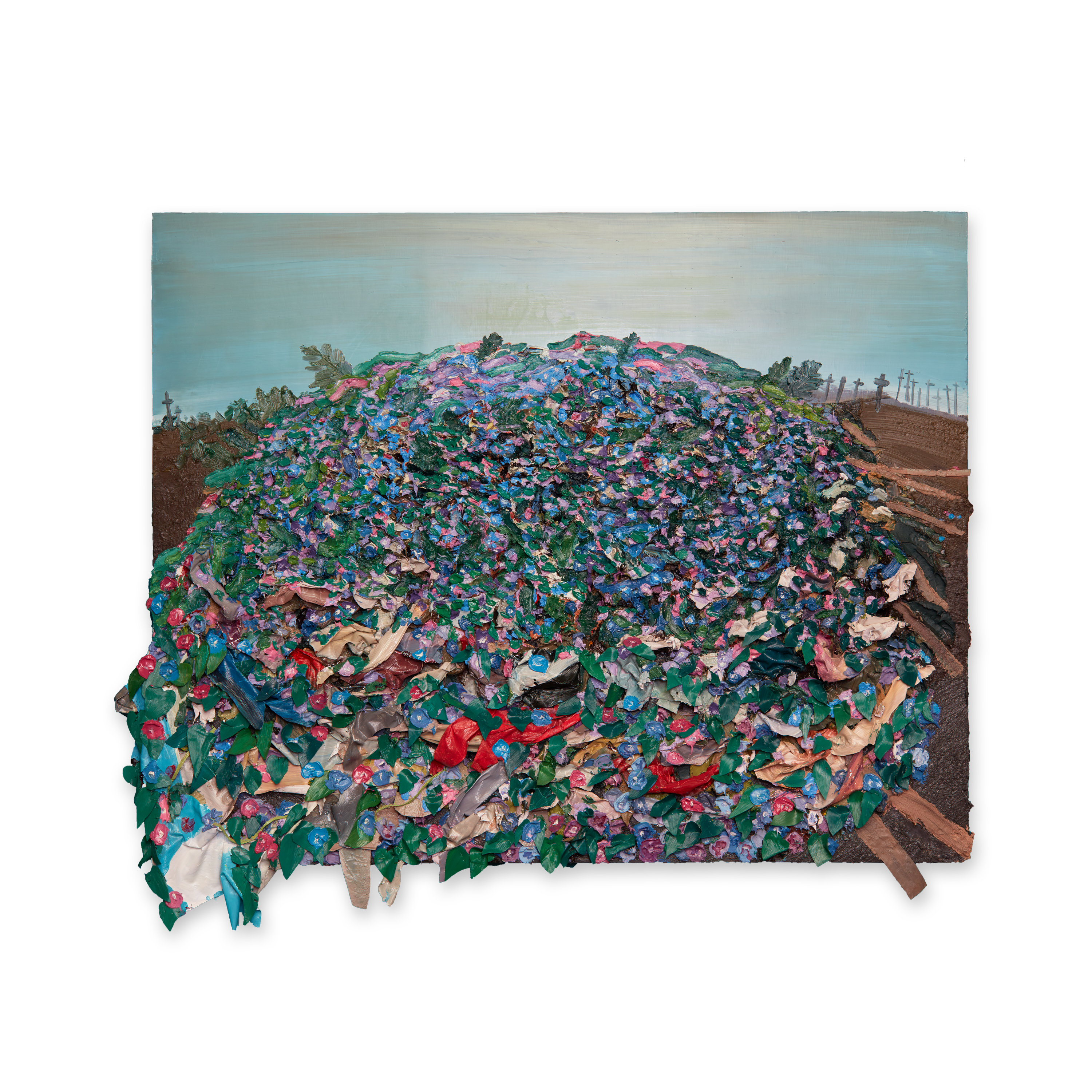Herman Aguirre
(Chicago, Illinois, 1992 - )
Vamos a darnos una vuelta al cielo (Let’s give heaven a visit)
2019
Oil and oil/acrylic skins on panel
53 x 64 x 4 1/2 in. (134.6 x 162.6 x 11.4 cm)
Collection of the Akron Art Museum
The Mary S. and Louis S. Myers Endowment Fund for Painting and Sculpture
2021.11
More Information
It is only appropriate here to begin with Aguirre’s own statement on Vamos a darnos una vuelta al cielo: “Let’s give heaven a visit references the discovery of children’s remains in burial pits on Sep. 23, 2018 in Veracruz, Mexico. The clothing found were near the bodies and cut free from the remains. In response to such shocking and traumatic events, I replicated the clothing found by using paint skins to represent the shirts worn by the children on the day of the massacre. As a memorial, I entangled the clothing with beautiful morning glory representing the innocence and purity of children. The fields of blues, violets, and pinks symbolize the overabundance of child disappearances, human trafficking, and murder. The lively corona is harmonious with the serene sky, ultimately signifying hope for a better tomorrow.” In 2018, Mexican authorities reported that this mass grave in Veracruz contained 168 human skulls and over 200 articles of clothing, the state of which suggested that the victims had been killed two years earlier. At the time, federal officials said that more than 30,000 people had disappeared in Mexico in the preceding decade, although human rights groups estimated the correct number to be much higher, with the total number of people killed in drug-related violence far surpassing 100,000 over the same period. The National Commission of Missing Persons posted online hundreds of pictures of the clothing discovered in Veracruz to give family members a tool to possibly identify missing loved ones. Like Aguirre, news reporters saw these relatively anonymous articles as symbolic of broader violence in Mexico. Amy Guthrie began her report for the Associated Press this way: “Tiny pants for a baby no older than 6 months and shiny pink sandals for a toddler are among the personal items that have turned up in mass graves in the Gulf state of Veracruz, driving home the brutality of rising violence in Mexico.” Even amid its specific, harrowing details, witnesses and writers could not help but see this event as emblematic of broader drug- and gang-related violence. Aguirre’s painting takes this line of thinking even further, abstracting the pieces of clothing into simple colors made from tactile paint skins and exaggerating their quantity so that they form a massive pile which extends towards the sky, suggesting the victims not only from this particular site, but from across Mexico more broadly. On top of the clothing, the artist added a vibrant array of flowers and leaves, forming a corona (a funerary display of flowers either as a wreath or, in this case, a large mound of flowers). Aguirre seems to strike a careful and hard-won balance between on the one hand the beauty of the colors in his paint and the alluring texture of his application of paint skins, and on the other hand the almost impossibly heavy subject matter at hand. If the visual richness draws viewers in, the content will keep them thinking. If the topic seems too dire to contemplate, the painting’s attractiveness allows it to function not as obscenely graphic reportage but as a gentler memorial, even an optimistic one. The titles leaves ambiguity in who might give heaven a visit—it might be the young victims of violence, but it might also be the viewers who remember them through this work. Through this physical and spiritual transportation, Aguirre indeed encourages hope for a better tomorrow.
Keywords
FlowersChildren
Mexican
Violence
WAR AND CONFLICT
Painting
Abstraction
Clothing
Politics

